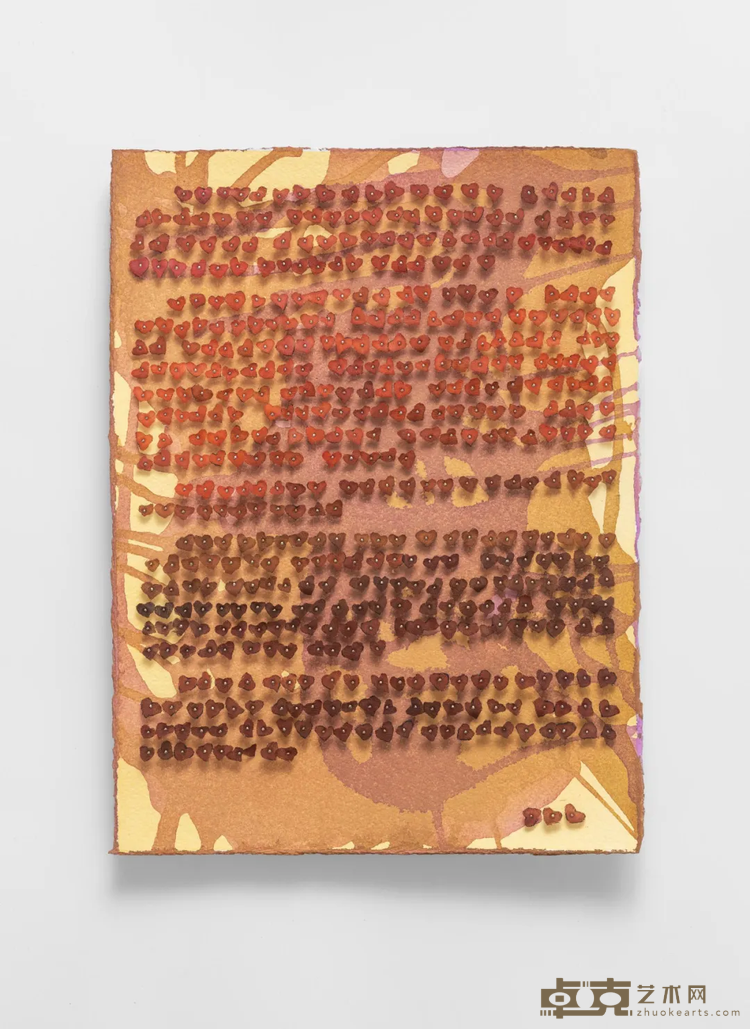麦勒画廊荣幸地宣布,我们将在苏黎世画廊空间推出中国艺术家张雪瑞(1979年生于山西)的个展“物静光时 II”。此次展览延续了艺术家2019年在麦勒画廊卢塞恩空间展示的独特抽象绘画脉络,对她近年来围绕“时间”和“物”的主题的创作进行了反思性总结。同时,这也是她2023年在北京空间展览的续篇和深化。以绘画和装置为媒介,张雪瑞展开了一场涵盖个体经验、家族历史、时间流逝、记忆更迭与情感变迁的对话。
Galerie Urs Meile is pleased to announce In Search of Lost Time II, the solo exhibition by Chinese artist Zhang Xuerui (b. 1979, Shanxi, China) at its Zurich gallery. This exhibition follows the thread of the artist's unique abstract painting showcased at the Galerie Urs Meile in Lucerne in 2019, providing a reflective summary of her recent works centered around the themes of "time" and "object." It is also a sequel and further extension of her 2023 exhibition at the gallery space in Beijing. Employing painting and installation as her mediums, Zhang Xuerui engages in a dialogue that encompasses her personal experiences, family history, the passage of time, memory, and emotion.
“在生活中难以实现的亲密关系,我希望能在绘画中得以体现。”
"In life, it is difficult to achieve intimacy, and I hope to express it through painting."
张雪瑞 Zhang Xuerui
张雪瑞的绘画是循序渐进的。她早期的纯抽象绘画通常捕捉自然中人类生存的本质,或通过时间的透镜对自然环境进行个人化诠释。那些不断变化的网格,承载着随岁月推移而更迭的体验与感悟,并逐渐凝聚成鲜明的元素和生动的画面,邀请观者进入她独特的内心世界。近年来,她的创作逐渐转向叙事性表达,使作品成为其传达个体与集体经验的重要载体。
Zhang Xuerui's paintings unfold a progressive course. Her early pure abstract paintings often capture the essence of human existence in nature, or offer the artist's personal interpretation of her natural surroundings through the lens of time. The evolving grid embodies shifting experiences over time, gradually giving rise to discernible elements that coalesce into a vivid tableau, drawing viewers into the artist's own domain. Her recent works shift to a narrative-driven approach, wherein the artwork becomes a significant vehicle for articulating her individuality and the collective experience.
本次展览的核心之一是她最新的“物格 · 沙发”系列作品。该系列则聚焦于一张单人沙发。童年时,家中有一张专属于父亲的沙发,他在家时无人可以染指。这在艺术家的记忆中象征着不可撼动的权威,因此给她留下了深刻的印象。由于父亲重男轻女的态度,张雪瑞一直对父亲怀着敬畏与疏离之心。双亲离婚以后,父亲再婚,父女间的联系愈渐淡漠。直到近年父亲的健康状况恶化,他才试图修复与女儿的关系。这种修复既源于情感需求,更出于对照料的实际渴望。面对父亲,张雪瑞难以完全原谅,也无法彻底忽视,因此她的回应有限而疏离。这种复杂的现实困境正是她想通过绘画表达的。反复出现在作品中的沙发象征着父亲或权威本身,时而清晰,时而朦胧,交替映射着她内心记忆与情感的起伏流转。
A key component of this exhibition is Zhang Xuerui's latest series Investigation Grid · Sofa,which features a single armchair. In the artist's childhood, there was a sofa that belonged exclusively to her father, who forbade anyone from sitting on it while he was home. For the artist, this sofa symbolizes power, leaving a profound impression in her memory. Due to her father's preference for sons over daughters, Zhang Xuerui has long harbored fear towards him, leading to a distant father-daughter relationship. After her parents divorced, her father remarried, and their contact diminished until his health declined a few years ago, prompting him to reach out to the artist in hopes of mending their relationship. This repair is driven by both emotional needs and, more importantly, the practical need for care. Zhang Xuerui finds it challenging to fully forgive or ignore her father, offering limited responses while maintaining distance. This real-life dilemma is something the artist aims to express through her paintings. The recurring image of the sofa symbolizes her father or authority itself—sometimes clear, sometimes blurred—mirroring the flow of her memory and emotion.

在另一系列“静物 · 箱子”作品中,打开的箱子被置于微妙的色彩之中,呈现出一种悬而未决的状态。它们是受家族传说启发的想象性构造,是承载关系动态、社会背景和历史记忆的容器。其中箱子原本由她外祖父为一位朋友保存,内藏珍贵古董瓷器。然而,在六十年代末期,这些艺术品惨遭销毁,外祖父也不幸失聪。多年后,那位朋友的后人来索要这只箱子,却在得知真相后黯然离去,只留下这只箱子作为家族历史的见证。箱子庞大而沉重,投射出艺术家细微的情感,其中既有对过去单纯美好的人际关系的怀念,也有与残酷的历史真相和解后余下的五味杂陈。
The series Still Life · Chest presents the open chest in a state of suspension within vibrant colors. These chests are imaginative constructs inspired by family lore, serving as vessels that embody relational dynamics, social context, and historical memory. One such chest was preserved by her grandfather for a family friend who fled away and once contained cherished antiquities and porcelain. Yet, in the late 1960s, these artworks were either boiled or destroyed. The grandfather suffered persecution during this period, resulting in a loss of hearing. The descendant of that friend later came to seek the chest but returned disheartened upon learning the truth, leaving the box as a remnant of the family history. In her mother's recollection, the box was large and heavy, projecting the artist's nuanced emotions, both the nostalgia for simple and beautiful interpersonal connections of the past, and lingering sentiment that remain after reconciling with harsh historical truths.

张雪瑞对色彩与生俱来的敏感使她得以凭此进入一个独特的感知领域。网格绘画技法代表了她将复杂觉察简化为日常实践的最自然的方式。通过这种劳动, 她追求着感性与理性的完美融合,力图在作品中凝练出纯粹的精神本质。画面背景的颜色选取延续了以往艺术家绘画创作中自我限定的方式,即在被方格分割的画面上选定三个角,将其中填充的颜色设定为这幅画的“三原色”——这些初始原色都在大自然中有迹可循——此后整个画面的所有方格都有着三原色按不同配比调试出的颜色填充而成,迭代出微妙的色彩渐变。这种工作方法本质上是理性的,因为这三种颜色决定了整体的色调。箱子和沙发的部分也遵循这个原则,不引入任何多余的色彩。艺术家的任务在于精心安排它们的分布与组合。
Zhang Xuerui possesses an innate sensitivity to color, enabling her to enter a unique experiential realm through it. The grid painting technique represents her most comfortable mean of simplifying complex perception into daily practice. Through this labor, she seeks perfection, aspiring for an exquisite blend of sensibility and rationality that culminates in a concentrated spiritual essence. The color palette in the background follows a self-imposed limitation wherein she designates three "primary colors" to three corners within the divided grid—these colors arise from internalized visual experiences expressed through unparalleled intuition. Subsequently, all the grids on the canvas are filled with shifting colors based on these three primary ones, creating subtle color gradations. This working method is inherently rational, as the three colors dictate the overall tone. The parts of the chests and sofas follow the rule as well, prohibiting the introduction of extraneous colors. The artist's task is to merely determine their distribution and arrangement.
装置作品“某年某月某日 · 手书”也源于艺术家对“物”的独特感知。“信件”作为一种私密的交流媒介,曾是她与密友沟通的珍贵方式。张雪瑞精心将布料裁剪成心形图案,用大头针固定在纸上,并根据创作时的心境和作品结构对纸张和心进行染色处理。她相信材料本身就蕴含着的意义与情感,这件作品中使用的纸张和大头针就唤起了一种痛感。
The installation Some Day Some Month Some Year · Handwritten Letter also draws upon the artist's perception of the "object". A "letter" serves as private medium for conveying information. Writing letters used to be a cherished method of communication with close friends for the artist. She meticulously cuts heart-shaped prints from fabric and pins them onto paper, dyeing both the paper and hearts in various colors based on her creative state and the construction of the work. She believes that materials inherently carry meanings and emotions, as seen in the use of paper and pins in her work, which evoke a sense of pain.

在张雪瑞对“时间”和“物”的探索中,箱子与沙发象征着重叠的时空。此次展出的系列作品恰创作于疫情隔离期,因而激发了对社会框架下人际关系、家庭联结以及集体存在的深入反思。在展厅中,这些新作通过暧昧而朦胧的色调描绘出幽微的形象,以熟悉的形式向我们展示着其中蕴含的欢愉与痛楚。
In Zhang Xuerui's explorations of "time" and "object," the chests and sofas represent overlapping temporalities. The creative processes of the work series on display coincided with the time of isolation during the pandemic, prompting reflections on interpersonal relationships, family ties, and collective existence within a societal framework. In the exhibition space, these recent works depict ghostly figures through subtle, hazy tones, presenting familiar forms that manifest the joy and pain imparts to us.

张雪瑞
Zhang Xuerui
张雪瑞(1979年生于山西),现工作、生活于北京,2004年毕业于中央美术学院。近期个展包括:“物静光时”,麦勒画廊,中国北京(2023);“三个航标的河流”,麦勒画廊,中国北京(2020);“作为本体的日常”,麦勒画廊,瑞士卢塞恩(2019); “微物之神”,巴塞尔艺术展迈阿密海滩展会“策展角落”,迈阿密,美国(2018);“色彩翩然而至”,狮语画廊,中国香港(2017);“张雪瑞新作”,今格空间,中国北京(2017)。群展包括:“废墟之蓝图”,白兔美术馆,澳大利亚新南威尔士州(2023);“文明的印记:敦煌艺术大展”,北京民生美术馆,中国北京(2022);“余生记”,红树林画廊,中国深圳(2022);“北京书信”,光州市立美术馆,韩国光州(2019);“中国当代艺术年鉴展2017”,北京民生现代美术馆,中国北京(2018);“相遇亚洲—多元化的青年艺术视觉”,四川美术学院美术馆,中国重庆(2018);“非形象—叙事的运动”,上海二十一世纪民生美术馆,中国上海(2015); “调节器:2010第二届今日文献展”,今日美术馆,中国北京(2010)。2015年参加了奥地利维也纳艺术家驻留项目“Kulturkontaka Austria”,其作品被白兔美术馆以及Cruthers Art Foundation等机构收藏。
Zhang Xuerui was born in 1979 in Shanxi, and currently lives and works in Beijing. She graduated from Central Academy of Fine Arts in Beijing in 2004. Her recent solo exhibitions include: In Search of Lost Time, Galerie Urs Meile, Beijing, China (2023); River with Three Buoys, Galerie Urs Meile, Beijing, China (2020); The Everyday as Ontology, Galerie Urs Meile, Lucerne, Switzerland (2019); The God of Small Things, Art Basel Miami Beach-Kabinett, Miami, USA (2018); Colours in A Breeze: Zhang Xuerui Solo Exhibition, Leo Gallery, Hong Kong, China (2017); Zhang Xuerui: Recent Works, Ginkgo Space, Beijing, China (2017). Recent group shows include: A Blueprint for Ruins, White Rabbit Gallery, Chippendale NSW, Australia (2023); The Trace of Civilization: The Great Art of Dunhuang, Beijing Minsheng Art Museum, Beijing, China (2022); A Descent into the Maelstrom, Mangrove Gallery, Shenzhen, China (2022); Letters from Beijing, Gwangju Museum of Art, Gwangju, Korea (2019); The Exhibition of Annual of Contemporary Art of China 2017, Minsheng Art Museum, Beijing, China (2018); Encounter Asia – Multi-vision of Youth Art, the Museum of Sichuan Fine Arts Institute, Chongqing, China (2018); Nonfigurative, Shanghai 21th Century Minsheng Art Museum, Shanghai, China (2015); Negotiations – The 2nd Today’s Documents 2010, Today Art Museum, Beijing, China (2010). She participated in Artist in Residence program "Kulturkontaka Austria" in Vienna in 2015. Her works have been collected by public collections including White Rabbit Gallery and Cruthers Art Foundation.







 皖公网安备 34010402700602号
皖公网安备 34010402700602号